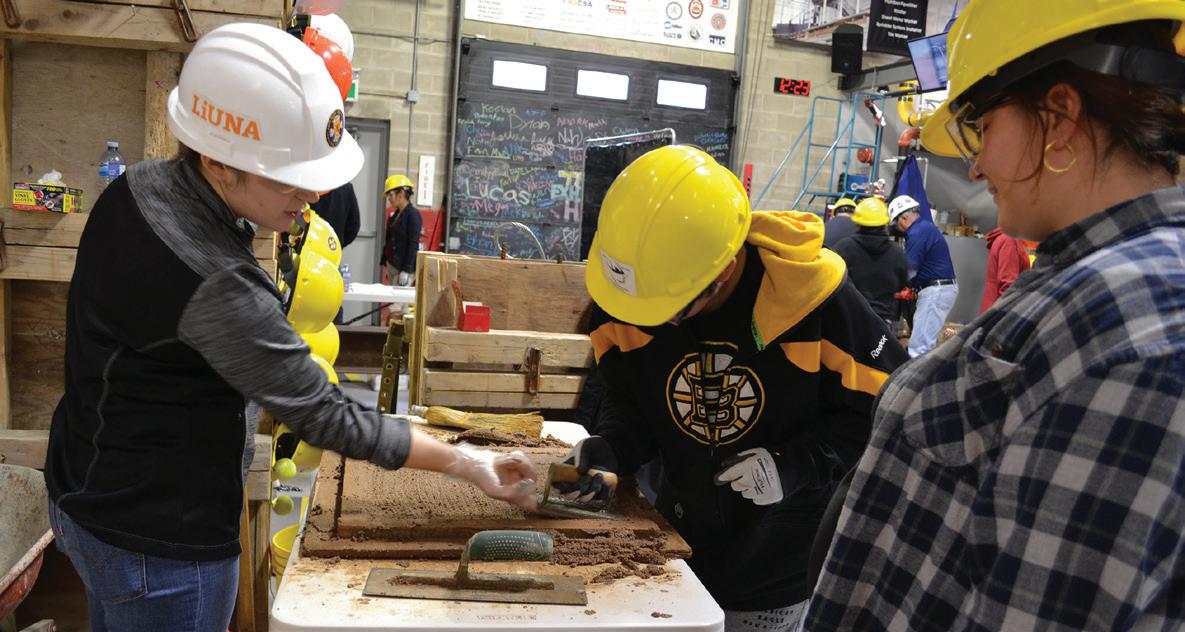
8 minute read
Beyond bricks and mortar
Photos contributed
An Aboriginal adult skilled-trades fair organized by Ann Sylliboy with Mi'kmaw Kina'matnewey was held at Nova Scotia Construction Sector Council's Trades Exhibition Hall in December.
Advertisement
It’s a quiet December afternoon in the Ragged Lake Business Park. But the Nova Scotia Construction Sector Council (NSCSC) premises are humming with activity, as a group of about 20 Aboriginal adults get some hands-on experience in construction trades at NSCSC’s Unique Trades Exhibition Hall.
Opened in 2014, the trades exhibition hall hosts some 70 groups of visitors every year. These guests can speak with industry professionals and then step into an interactive booth to experience firsthand what it would be like to work as a welder, plumber, heavy equipment operator, bricklayer, electrician, boilermaker, carpenter/millwright, sheet metal worker or in various other trades.
“People can get a sense of whether they want to work in construction or not,” explains NSCSC Executive Director, Trent Soholt. “They can try things out before they make a decision to go down that path.” Diversity in procurement adds value to construction process By Joey Fitzpatrick Groups visit the trades exhibition hall from high schools, colleges and various community organizations and today’s visiting group is part of an Aboriginal Adult Skilled Trades Fair. Barely a kilometre from NSCSC’s office a clear cutting is making way for a new community outpatient centre in Bayers Lake. When completed the $100 million facility will offer improved access and parking for clinical visits for blood collection, x-rays and other services.
The new outpatient centre is just one of a number of capital projects unfolding across Nova Scotia, including a $230 million Cape Breton Regional hospital and $116 million each for new hospitals in North Sydney and New Waterford. Together with new schools, utilities and transportation projects, they represent billions in capital investment by the province over the next five years.
As government looks for better ways to deliver health-care services to Nova Scotians, there is a parallel imperative to make a social impact with those public investments, or in the words of Premier Stephen McNeil, to “leave a legacy for Nova Scotia.”
“Those capital investments have to deliver the best value to Nova Scotians,” Soholt says. “But they also have to meet some of the priorities set out by government.”
One of those priorities is diversity of participation — ensuring that populations historically under-represented in the construction sector, including Aboriginals, African Nova Scotians, people with disabilities, women and immigrants, are able to take part and reap the benefits.
Procurement has been identified as an area of great potential for bringing these under-represented groups into the process.
Soholt says. “Now we’re realizing that procurement is a prime example of where change can really happen.”
NSCSC is a not-for-profit that works with all industry stakeholders, including contractors, unions, training providers and government.
“We’re like a project management office for anything that’s impacting the industry,” Soholt explains. “This could be labour market research, youth engagement, best practices, health and safety or human resources. Our member organizations come to us and we find the appropriate channels, resources, funding or expertise to address the issues.” Procurement has been part of NSCSC’s strategic plan for a number of years and it was in 2016 that the issue was put on the front burner. In 2017 NSCSC, in partnership with the Construction Association of Nova Scotia and the Design and Construction Institute, hosted a pro- curement day that included 120 individ- uals from various sectors, with a focus on transparency, fairness and sustainability. “We came out with a report with a series of recommendations for govern- ment to consider.”
Part of the process is gathering insight and research on what has been done in other jurisdictions that have used procurement policies to promote diver- sity and inclusion.
“Different models have started to evolve in Europe, the U.S. and other parts of Canada that use procurement to have a long-term impact.”
Canada’s federal government procurement process has implemented requirements for Indigenous engagement and participation for other under-repre- sented groups, as well as requirements for environmental sustainability.
“They’ve taken a proactive approach, rather than just assuming diversity will eventually happen,” Soholt says. “We have to be more prescriptive in what we define as success.”
Community Benefit Agreements (CBA) have been used for years in real estate development, as a contract between the developer and community groups to provide certain amenities or local improvements. CBAs are now beginning to be employed in public procurement in some jurisdictions to add social benefits to the construction process. CBAs are built into the tender process and the government can add any number of stipulations as the client. This could include requirements such as:

Construction Safety Nova Scotia Announces New CEO
Construction Safety Nova Scotia is pleased to announce that the board of directors has appointed MJ MacDonald as the new CEO. With over 30 years of executive leadership experience within the public and private sectors, workplace healthcare and safety culture has remained a common thread throughout her career.
MJ’s career in safety in the construction industry began with Black and McDonald where she worked as an engineer. It was during this time that her passion for safety grew profoundly and remained with her as she delivered progress across sectors.
As Executive Director with the Department of Health and Wellness’ Continuing Care branch, MJ worked closely with other system partners such as WCB, AWARE NS, NSGEU, Nurses Union and many others.
“I am very excited to return to my roots and work collaboratively with our partners to make Nova Scotia the safest, most productive, innovative and prosperous construction sector in Canada.”
– MJ MacDonald
MJ holds an Executive MBA from Saint Mary’s University, a Bachelor of Mechanical Engineering from the Technical University of Nova Scotia, as well as a Diploma of Engineering from St. Francis Xavier University.

Construction Safety Nova Scotia is an industry founded not-for-profi t organization committed to improving Occupational Health and Safety outcomes in the construction industry through training, research, engagement and mentorship. For training and resources please visit us online at constructionsafetyns.ca
We want all building materials to be sourced locally; we want materials that are harvested in a sustainable fashion; we want local workers hired; we want to see opportunities for people with disabilities. Nova Scotia’s Public Procurement Act, passed in 2011, requires public sector entities to consider social factors, such as inclusiveness and fair wages, in the tendering process. However, the 2015 Auditor General’s report concluded that “the province does not do a good job of assessing the effectiveness of the procurement process in meeting the objectives.”
Figuring out how to incorporate diversity into a nuanced and complex industry like construction is no simple matter. For example, will it be the general contractor’s responsibility to ensure a diverse workforce is employed all the way through the supply chain? Or should that be the responsibility of the subcontractors?
“In some jurisdictions the government is involved in the procurement processes of the sub-trades to ensure that the metrics are achieved,” Soholt points out. “In other jurisdictions it’s the responsibility of the general contractor.” There are many pieces to the puzzle, including languages in tenders, training practices, recruitment and mentorship. “When we have big projects underway it tends to bring more mentorship opportunities, where younger people can come into the industry and be trained by a qualified, certified tradesperson.”
Apprentices from under-represented groups can then see themselves in the success of their mentors and then become mentors themselves in the next round of projects.
“This builds that succession cycle,” Soholt says. “So as these projects wrap up we have a well trained, ready-to-go workforce.”
Apprenticeship is a regulated training process for the skills trades and there are roughly 7,000 registered apprentices in Nova Scotia, in every sector from automotive repair to boatbuilding. Approximately 2,700 of those apprentices come from the building trades.
“The apprenticeship system is the core of the construction industry,” says Brad Smith, Executive Director of Mainland Nova Scotia Building Trades. Having apprenticeship tied directly to the procurement process would address both the skills gap and diversity issues. Some companies in Western
Procurement has typically been: Lowest bid wins the project. There’s always somebody who can do it cheaper. Now we’re realizing that procurement is a prime example of where change can really happen.” — Trent Soholt, Executive Director, Nova Scotia Construction Sector Council

Canada, including Syncrude and Shell, already require a minimum of 25 per cent apprentices on their worksites.
“They understand that you need to invest in the apprenticeship system to get the skilled trades that you need for the future,” says Smith. “Government procurement could require the same thing.” “That’s where we can really grow the population with those skill sets and this can be monitored and measured,” Soholt adds. “For example, I’ve seen community benefit agreements that say 25 per cent of the workforce will be apprentices and of that 25 per cent, 15 per cent will be Indigenous and another percentage will be women. Those don’t have to be the exact numbers, but that’s how the concept works.”
By bringing more people into the industry and providing job opportunities for young people, diversity in procurement can also help to offset the demographic imbalance in a province with an aging population, where more people are retiring than are entering the workforce. The industrial/commercial/institutional construction sector supported by
NSCSC employs approximately 15,000 people. Together with the other two pillars of the construction industry, road building and residential, Nova Scotia’s construction sector employs between 30,000 and 35,000 people. Depending on the level of activity in a given year, the sector accounts for between six and 10 per cent of the province’s GDP, or as much as $4 billion annually.
Taxpayers will still demand prudent use of their hard-earned dollars. But at the same time consumers are already making value decisions with their purchasing power — by buying locally, purchasing organic produce and buying from environmentally responsible producers. Using procurement policies to both expand and diversify Nova Scotia’s skilled trades workforce is a natural next step to enhance participation in the province’s economy.
“It’s looking beyond the dollars invested to build a sustainable social procurement process,” Soholt says. “We need to look at building something bigger that will impact the social well being of Nova Scotia.” ■










